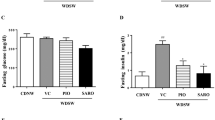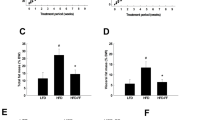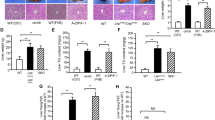Abstract
AIMS/HYPOTHESIS:
Fibrates and thiazolidinediones are commonly used for the treatment of dyslipidemia and type 2 diabetes, respectively. The aim of this study was to investigate the effects on body weight as well as on glucose and lipid homeostasis of ligands for PPARα and PPARγ, Fenofibrate and Rosiglitazone, alone or in association.
METHODS:
Ob/ob mice were divided into four groups: control, and mice daily injected (intraperitoneally), either with 10 mg/kg Rosiglitazone, 100 mg/kg Fenofibrate or both molecules. Body weight and food intake were monitored daily. After 13 days of treatment, mice were killed, and blood samples were collected for posterior metabolite quantification. The liver and adipose tissues were dissected and weighed.
RESULTS:
Body weight was significantly reduced or increased by Fenofibrate and Rosiglitazone, respectively. The effect of Rosiglitazone was prevented by coadministration of Fenofibrate. This was accompanied by a normalization of the daily food efficiency. Compared to those treated with Rosiglitazone, animals treated with Fenofibrate alone or in combination presented a decreased white adipose tissue mass. Fenofibrate or Rosiglitazone alone significantly reduced the levels of plasma lipid parameters. Surprisingly, Fenofibrate also decreased blood glucose levels in ob/ob mice, despite having no effect on insulin levels. By contrast, both glucose and insulin levels were decreased by Rosiglitazone treatment. Coadministration of both drugs improved all parameters as with Rosiglitazone. Fenofibrate restored almost normal hepatocyte morphology and significantly reduced the triglyceride content of the liver. This was accompanied by an increase in fatty acid oxidation in the liver in all groups receiving Fenofibrate.
CONCLUSION/INTERPRETATION:
These biological effects suggest that combined therapy with a PPARα and a PPARγ ligand is more effective in ameliorating, specifically, lipid homeostasis than in activating any of this receptor separately. Furthermore, Fenofibrate prevents one of the most undesirable effects of Rosiglitazone, namely increased adiposity and body weight gain.
This is a preview of subscription content, access via your institution
Access options
Subscribe to this journal
Receive 12 print issues and online access
$259.00 per year
only $21.58 per issue
Buy this article
- Purchase on Springer Link
- Instant access to full article PDF
Prices may be subject to local taxes which are calculated during checkout



Similar content being viewed by others
References
Goldstein BJ . Differentiation members of the thiazolidinedione class: a focus on efficacy. Diabetes Metab Res Rev 2002; 18: S16–S22.
Giguere V . Orphan nuclear receptors: from gene to function. Endocr Rev 1999; 20: 689–725.
Mukherjee R, Jow L, Croston GE, Paterniti Jr JR . Identification, characterization, and tissue distribution of human peroxisome proliferator-activated receptor (PPAR) isoforms PPARgamma2 versus PPARgamma1 and activation with retinoid X receptor agonists and antagonists. J Biol Chem 1997; 272: 8071–8076.
Vidal-Puig A, Jimenez-Linan M, Lowell BB, Hamann A, Hu E, Spiegelman B, Flier JS, Moller DE . Regulation of PPAR gamma gene expression by nutrition and obesity in rodents. J Clin Invest 1996; 97: 2553–2561.
Vidal-Puig AJ, Considine RV, Jimenez-Liñan M, Werman A, Pories WJ, Caro JF, Flier JS . Peroxisome-proliferator activated receptor gene expression in human tissues. Effects of obesity, weight loss, and regulation by insulin and glucocoticoids. J Clin Invest 1997; 99: 2416–2422.
MacDougald OA, Mandrup S . Adipogenesis: forces that tip the scales. Trends Endocrinol Metab 2002; 13: 5–11.
Chaput E, Saladin R, Silvestre M, Edgar AD . Fenofibrate and Rosiglitazone lower serum triglycerides with opposing effects on body weight. Biochem Biophys Res Commun 200; 271: 445–450.
Hallakou S, Doare L, Foufelle F, Kergoat M, Guerre-Millo M, Berthault MF, Dugail I, Morin J, Auwerx J, Ferre P . Pioglitazone induces in vivo adipocyte differentiation in the obese Zucker fa/fa rat. Diabetes 1997; 46: 1393–1399.
Kelly IE, Han TS, Walsh K, Lean ME . Effects of a thiazolidinedione compound on body fat and fat distribution of patients with type II diabetes. Diabetes Care 1999; 22: 288–293.
Lenhard JM, Lancaster ME, Paulik MA, Weiel JE, Binz JG, Sundseth SS, Gaskill BA, Lightfoot RM, Brown HR . The RXR agonist LG100268 causes hepatomegaly, improves glycaemic control and decreases cardiovascular risk and cachexia in diabetic mice suffering from pancreatic beta-cell dysfunction. Diabetologia 1999; 42: 545–554.
Miyazaki Y, Glass L, Triplitt C, Matsuda M, Cusi K, Mahankali A, Mahankali S, Mandarino LJ, DeFronzo RA . Effect of Rosiglitazone on glucose and non-esterified fatty acid metabolism in type II diabetic patients. Diabetologia 2001; 44: 2210–2219.
Schwartz S, Raskin P, Fonseca V, Graveline JF . Effect of troglitazone in insulin-treated patiens with type II diabetes mellitus. N Engl J Med 1998; 338: 861–866.
Kletzien RF, Clarke SD, Ulrich RG . Enhancement of adipocyte differentiation by an insulin-sensitizing agent. Mol Pharmacol 1992; 41: 393–398.
Tontonoz P, Hu E, Graves RA, Budavari AI, Spiegelman BM . mPPARγ2: a tissue-specific regulator of an adipocyte enhancer. Genes and Development 1994; 8: 1224–1234.
Tontonoz P, Hu E, Spiegelman BM . Stimulation of adipogenesis in fibroblast by PPARγ2, a lipid-activated transcription factor. Cell 1994; 79: 1147–1158.
Issemann I, Green S . Activation of a member of the steroid hormone receptor superfamily by peroxisome proliferators. Nature 1990; 347: 645–650.
Auboeuf D, Rieusset J, Fajas L, Vallier P, Frering V, Riou JP, Staels B, Auwerx J, Laville M, Vidal H . Tissue distribution and quantification of the expression of mRNAs of peroxisome proliferator-activated receptors and liver X receptor-alpha in humans: no alteration in adipose tissue of obese and NIDDM patients. Diabetes 1997; 46: 1319–1327.
Braissant O, Foufelle F, Scotto C, Dauca M, Wahli W . Differential expression of peroxisome proliferator-activated receptors (PPARs): tissue distribution of PPAR-alpha, -beta, and -gamma in the adult rat. Endocrinology 1996; 137: 354–366.
Chinetti G, Griglio S, Antonucci M, Torra IP, Delerive P, Majd Z, Fruchart JC, Chapman J, Najib J, Staels B . Activation of proliferator-activated receptors alpha and gamma induces apoptosis of human monocyte-derived macrophages. J Biol Chem 1998; 273: 25573–25580.
Inoue I, Shino K, Noji S, Awata T, Katayama S . Expression of peroxisome proliferator-activated receptor alpha (PPAR alpha) in primary cultures of human vascular endothelial cells. Biochem Biophys Res Commun 1998; 46: 370–374.
Linton MF, Fazio S . Re-emergence of fibrates in the management of dyslipidemia and cardiovascular risk. Curr Atheroscler Rep 2000; 2: 29–35.
Goldberg R, La Belle P, Zupkis R, Ronca P . Comparison of the effects of lovastatin and gemfibrozil on lipids and glucose control in non-insulin-dependent diabetes mellitus. Am J Cardiol 1990; 66: 16B–21B.
Staels B, Dallongeville J, Auwerx J, Schoonjans K, Leitersdorf E, Fruchart JC . Mechanism of action of fibrates on lipid and lipoprotein metabolism. Circulation 1998; 98: 2088–2093.
Mancini FP, Lanni A, Sabatino L, Moreno M, Giannino A, Contaldo F, Colantuoni V, Goglia F . Fenofibrate prevents and reduces body weight gain and adiposity in diet-induced obese rats. FEBS Lett 2001; 491: 154–158.
Yoon M, Jeong S, Nicol CJ, Lee H, Han M, Kim JJ, Seo YJ, Ryu C, Oh GT . Fenofibrate regulates obesity and lipid metabolism with sexual dimorphism. Exp Mol Med 2002; 34: 481–488.
Idzior-Walus B, Sieradzki J, Rostworowski W, Zdzienicka A, Kawalec E, Wojcik J, Zarnecki A, Blane G . Effects of comicronised fenofibrate on lipid and insulin sensitivity in patients with polymetabolic syndrome X. Eur J Clin Invest 2000; 30: 871–878.
Brand CL, Sturis J, Gotfredsen CF, Fleckner J, Fledelius C, Hansen BF, Andersen B, Ye JM, Sauerberg P, Wassermann K . Dual PPARalpha/gamma activation provides enhanced improvement of insulin sensitivity and glycemic control in ZDF rats. Am J Physiol Endocrinol Metab 2003; 284: E841–E854.
Etgen GJ, Oldham BA, Johnson WT, Broderick CL, Montrose CR, Brozinick JT, Misener EA, Bean JS, Bensch WR, Brooks DA, Shuker AJ, Rito CJ, McCarthy JR, Ardecky RJ, Tyhonas JS, Dana SL, Bilakovics JM, Paterniti Jr JR, Ogilvie KM, Liu S, Kauffman RF . A tailored therapy for the metabolic syndrome: the dual peroxisome proliferator-activated receptor-alpha/gamma agonist LY465608 ameliorates insulin resistance and diabetic hyperglycemia while improving cardiovascular risk factors in preclinical models. Diabetes 2002; 51: 1083–1087.
Murakami K, Tobe K, Ide T, Mochizuki T, Ohashi M, Akanuma Y, Yazaki Y, Kadowaki T . A novel insulin sensitizer acts as a coligand for peroxisome proliferator-activated receptor-alpha (PPAR-alpha) and PPAR-gamma: effect of PPAR-alpha activation on abnormal lipid metabolism in liver of Zucker fatty rats. Diabetes 1998; 47: 1841–1847.
Yajima K, Hirose H, Fujita H, Seto Y, Fujita H, Ukeda K, Miyashita K, Kawai T, Yamamoto Y, Ogawa T, Yamada T, Saruta T . Combination therapy with PPARgamma and PPARalpha agonists increases glucose-stimulated insulin secretion in db/db mice. Am J Physiol Endocrinol Metab 2003; 284: E966–E971.
Ye JM, Doyle PJ, Iglesias MA, Watson DG, Cooney GJ, Kraegen EW . Peroxisome proliferator-activated receptor (PPAR)-alpha activation lowers muscle lipids and improves insulin sensitivity in high fat-fed rats: comparison with PPAR-gamma activation. Diabetes 2001; 50: 411–417.
Hara A, Radin NS . Lipid extraction of tissues with a low-toxicity solvent. Anal Biochem 1978; 90: 420–426.
Morio B, Hocquette JF, Montaurier C, Boirie Y, Bouteloup-Demange C, McCormack C, Fellmann N, Beaufrere B, Ritz P . Muscle fatty acid oxidative capacity is a determinant of whole body fat oxidation in elderly people. Am J Physiol Endocrinol Metab 2001; 280: E143–E149.
Berger J, Leibowitz MD, Doebber TW, Elbrecht A, Zhang B, Zhou G, Biswas C, Cullinan CA, Hayes NS, Li Y, Tanen M, Ventre J, Wu MS, Berger GD, Mosley R, Marquis R, Santini C, Sahoo SP, Tolman RL, Smith RG, Moller DE . Novel peroxisome proliferator-activated receptor (PPAR) gamma and PPARdelta ligands produce distinct biological effects. J Biol Chem 1999; 274: 6718–6725.
Edvardsson U, Bergstrom M, Alexandersson M, Bamberg K, Ljung B, Dahllof B . Rosiglitazone (BRL49653), a PPARgamma-selective agonist, causes peroxisome proliferator-like liver effects in obese mice. J Lipid Res 1999; 40: 1177–1184.
Wang PR, Guo Q, Ippolito M, Wu M, Milot D, Ventre J, Doebber T, Wright SD, Chao YS . High fat fed hamster, a unique animal model for treatment of diabetic dyslipidemia with peroxisome proliferator activated receptor alpha selective agonists. Eur J Pharmacol 2001; 427: 285–293.
Guerre-Millo M, Gervois P, Raspe E, Madsen L, Poulain P, Derudas B, Herbert JM, Winegar DA, Willson TM, Fruchart JC, Berge RK, Staels B . Peroxisome proliferator-activated receptor alpha activators improve insulin sensitivity and reduce adiposity. J Biol Chem 2000; 275: 16638–16642.
Lee HJ, Choi SS, Park MK, An YJ, Seo SY, Kim MC, Hong SH, Hwang TH, Kang DY, Garber AJ, Kim DK . Fenofibrate lowers abdominal and skeletal adiposity and improves insulin sensitivity in OLETF rats. Biochem Biophys Res Commun 2002; 296: 293–299.
Ye JM, Iglesias MA, Watson DG, Ellis B, Wood L, Jensen PB, Sorensen RV, Larsen PJ, Cooney GJ, Wassermann K, Kraegen EW . PPARalpha/gamma ragaglitazar eliminates fatty liver and enhances insulin action in fat-fed rats in the absence of hepatomegaly. Am J Physiol Endocrinol Metab 2003; 284: E531–E540.
Pelleymounter MA, Cullen MJ, Baker MB, Hecht R, Winters D, Boone T, Collins F . Effects of the obese gene product on body weight regulation in ob/ob mice. Science 1995; 269: 540–543.
De Vos P, Lefebvre AM, Miller SG, Guerre-Millo M, Wong K, Saladin R, Hamann LG, Staels B, Briggs MR, Auwerx J . Thiazolidinediones repress ob gene expression in rodents via activation of peroxisome proliferator-activated receptor gamma. J Clin Invest 1996; 98: 1004–1009.
Acknowledgements
We acknowledge the help of the staff of the Animal Quarter from the IFR 31 and more specially JM Lerme and Y Barreira in taking care of the animals. We thank B Girier for providing the PIXIMUS apparatus and his help in analyzing the data and B Morio for setting the palmitic acid oxidation technique.
This study was supported by the Centre National de la Recherche Scientifique and by a grant in aids from the Institut de Recherches Internationales Servier (IRIS).
Author information
Authors and Affiliations
Corresponding author
Rights and permissions
About this article
Cite this article
Carmona, M., Louche, K., Nibbelink, M. et al. Fenofibrate prevents Rosiglitazone-induced body weight gain in ob/ob mice. Int J Obes 29, 864–871 (2005). https://doi.org/10.1038/sj.ijo.0802943
Received:
Revised:
Accepted:
Published:
Issue Date:
DOI: https://doi.org/10.1038/sj.ijo.0802943
Keywords
This article is cited by
-
Signaling mechanisms in renal compensatory hypertrophy revealed by multi-omics
Nature Communications (2023)
-
Transmembrane protein 135 regulates lipid homeostasis through its role in peroxisomal DHA metabolism
Communications Biology (2023)
-
A novel dual PPAR-γ agonist/sEH inhibitor treats diabetic complications in a rat model of type 2 diabetes
Diabetologia (2018)
-
Benzbromarone, an old uricosuric drug, inhibits human fatty acid binding protein 4 in vitro and lowers the blood glucose level in db/db mice
Acta Pharmacologica Sinica (2013)
-
Vanadyl acetylacetonate upregulates PPARγ and adiponectin expression in differentiated rat adipocytes
JBIC Journal of Biological Inorganic Chemistry (2013)



